After I posted my article about the International Slow Food Fair in Bijelo Polje, I really felt the need to write another post about the highlights of this beautiful town, as it has a lot to offer to tourists and other visitors.
Although Bijelo Polje seems to be somewhat off the track for those who are interested in a beach holiday on the Montenegrin Coast, it is very attractive for lovers of cultural sites and natural beauties.

Bijelo Polje is situated in the picturesque valley of the Lim River and it is surrounded by high mountains. By the way: it is also the town of festivals and other annual events, as it is the biggest town in the northern part of Montenegro (the municipality has around 46,000 inhabitants).
Bijelo Polje means – in translation – ‘White Field’. Why did the town get such a beautiful and extraordinary name? According to legend, in this very place there was once an endless field of daisies.
Under this name, it was mentioned for the first time in a document from the notary archives in Kotor from 1589. In the 17th century, the Turks called this place Akovo, which has the same meaning. In those times it was a well-known station at the crossroads of caravan roads from and to Dubrovnik.
Reading this post about Bijelo Polje, you can discover the most interesting sites in town by yourself. But if you need more details, you can address to the local Tourism Organization, which has issued a nice city map. This map also includes the tourist attractions in the surrounding villages, along with a detailed description.
Let’s start from the most famous attraction of Bijelo Polje: the medieval Church of St. Peter the Apostle. This is the place where a settlement started to develop 800 years ago. Miroslav, the Duke of Hum, built this church in 1196 in Romanesque and Byzantine style. The church was reconstructed several times and in the 16th century it was turned into a mosque.
The church is particularly famous for the fact that the builder, Duke Miroslav, ordered the creation of a special, luxuriously decorated church book, which was later called Miroslav Gospel. As it was written at the end of the 12th century, it is the oldest preserved Cyrillic manuscript in the Serbian language and it has been listed in the UNESCO’s Memory of the World register. The original manuscript is kept in Belgrade.

The Town Mosque or Gushmir Mosque, on the other side of the main road, is now in the phase of reconstruction. It was once located in the nearby village of Jabučino. Feeling that it would be left to the ravages of time after the Turkish army retreated from that area, the locals relocated it to this place, stone by stone, with their bare hands, over a period of two days.
If we start from the main square, we can make an interesting walk through the center of the town. The square, once a daisy field, is not only the center of social life and a gathering place for the inhabitants of Bijelo Polje, it is also the central place for the organization of festivals and other events. Apart from the International Slow Food fair, Bijelo Polje is also is well-known for the White Field Jazz Festival (in July) and the festival of Tamburitsa Orchestras (in August).
The square is dominated by a huge memorial monument, the Freedom Monument, which is dedicated to the fallen fighters from this area, who were killed in World War II. This statue was made by Stefan Bednarov in the typical socialist-realistic style that is characteristic for many war monuments in the countries of ex-Yugoslavia.
When you are on the square and you look up to the Ćukovac hill at the end of the main street, you will see a big five-pointed metal star with an unusual story. This star was made in honor of the arrival of Josip Broz Tito in Bijelo Polje, together with the inscription ‘Tito’. Then in the turbulent 1990s both memorials disappeared. However, a group of citizens took the 500 kg heavy star back to its original place, where it is still standing.

Follow the main street in the opposite direction, to the bridge over the Lim River. Along the street you can see many shops, pubs and restaurants with open-air terraces. If you want to make a break for breakfast, order some of the special food products of the region: ‘heljdija’ (a pie made of buckwheat flour with sour cream) or ‘mantije’ (a kind of pie made of small pieces of rolled pastry, baked and topped with sour milk). A traditional specialty for lunch or dinner is ‘jagnjetina u mlijeku’ (lamb in milk).
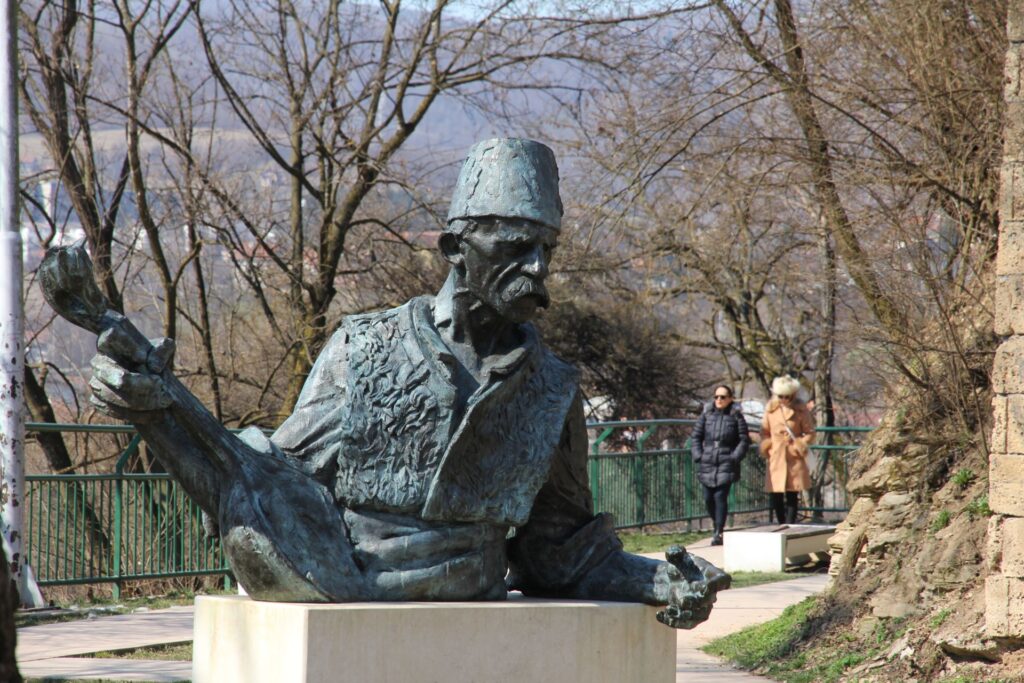
At the end of the main street, on the very bank of the Lim River, you will discover the quiet Park of Poets (see photo 1) with memorials to three of Bijelo Polje’s famous writers, whose stone busts look out over the river: Ćamil Sijarić, Miodrag Bulatović and Risto Ratković, the first Montenegrin novelist. His birth house is one of the most beautiful houses in Bijelo Polje, a typical example of oriental architecture from the beginning of the 20th century.
The most striking sculpture in the park is dedicated to Avdo Međedović, a well-known epic poet, born in 1875 in Bijelo Polje. Avdo was illiterate, but he could sing a thousand of verses he all knew by heart.

Go down to the bridge and you will have a nice view of the river. But when you return to the park and turn left behind the yellow building, you will pass through a steep and narrow street, where you can still see examples of local architecture and remainders of craft workshops. What a pity that this street has not been preserved in its traditional style! It would have been an important attraction for visitors.
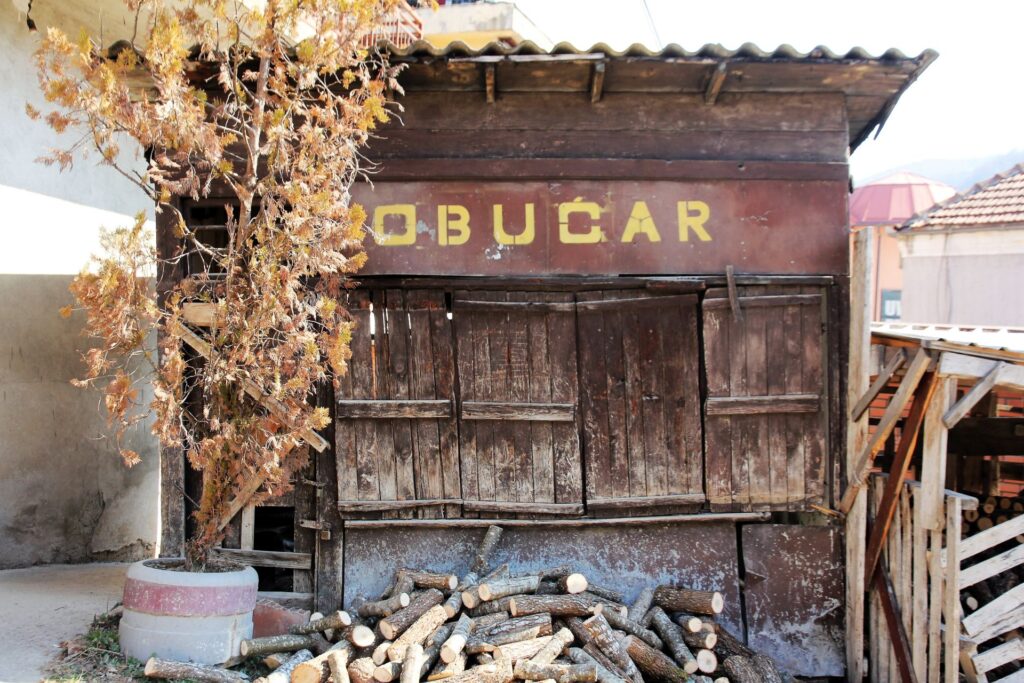
The Homeland Museum, once a secular secondary school, contains various historic and art collections. Altogether, it possesses almost 5,000 exhibits from prehistoric times up to World War II. In the ethnographic department, you can see how the interior of a town house in Bijelo Polje looks like and how people were dressed in the old times. But the Museum also contains numismatic, archeological and artistic collections.
Turn right after the Homeland Museum, pass the Cultural Center and return to the main square. By the way, last month I was lucky to attend a concert organized by Folklore Society KUD ‘Tekstilac’ in this cultural center. It was a fantastic experience!
I really love songs and dances from the countries of ex-Yugoslavia. KUD ‘Tekstilac’ was founded in 1964 within the Wool Factory of Bijelo Polje, but is now part of the Cultural Center. It consists of young people of different ethnic origin, who try to keep the traditional folk dances and music from oblivion. The ensemble has participated in many national and international folklore festivals and other events. With 20 choreographies of folk dances from all regions of ex-Yugoslavia, dressed in original national costumes and accompanied by their own orchestra, they have achieved much success in Germany, Italy, Switzerland, Turkey, Poland and many other countries.
But let’s not forget to mention the famous mineral springs near Bijelo Polje, which have been used since ancient times. They are the reason that a successful water factory called ‘Mineralna voda Rada’ was built in Bijelo Polje.
According to legend, fairies from Mount Bjelasica washed their faces with this water and they owed their eternal youth and beauty to this healing spring.
After your visit to Bijelo Polje, there are several tourist attractions in the surroundings that deserve to be visited. Around 20 km away is the village of Bistrica, the most beautiful part of the municipality. The stone bridge of Bistrica is the oldest monument from the Ottoman period in this area. Legend says that it was built with a special mortar, made with eggs and milk obtained from the surrounding villages.
Another highlight in this area is, no doubt, the monastery of St. Nicholas in Podvrh. This is the place where a new cable car is under construction, which should connect the place with the Đalovića Cave, one of the most promising and interesting caves of the Balkans.
The cave has been a point of research since 1987 and since then the stunning interior of the cave has left many speleologists in awe. It is unknown what lengths its corridors are, but cavers have explored more than 16 km so far.
When the road is finished and the cable car line – with a length of 1.7 km – constructed, the cave will be made accessible to tourists. A huge project indeed that will make the long-lasting dream of the population – to develop tourism in this area – come true!
This will also bring the isolation of Podvrh to an end, as this monastery is located exactly at the starting point of the cable car. This monastery, built in 1606 and dedicated to St. Nicholas, does not look like a sanctuary. In size and shape it resembles a shepherd’s hut, built far from the village at an altitude of 770 meters above sea level.

Are you one of those travelers who want to discover less-known places in Montenegro that are not frequented by hundreds or thousands of tourists? Enjoy your visit to the region of Bijelo Polje!
Info:
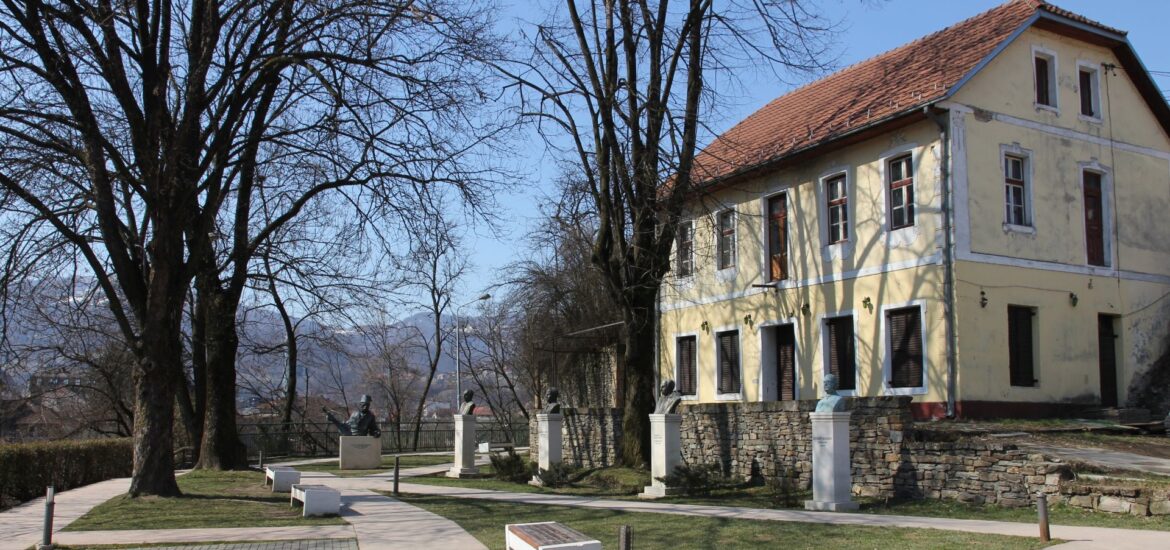
Hello Marianne. Thank you so much for putting this together. I have to confess that I didn’t even know where this town was until this morning. I am headed to Montenegro for the first time with my mother in about three weeks. We arrive in Podgorica on a Saturday afternoon at around 4 pm by plane. It looks like the earliest train we can get on is the 7 pm train out of Podgorica which will get us to Bijelo Polje by around 9:30 pm. This effectively means that we will spend that first day in travel and since this will be post sunset, we won’t be to get any scenery at all. Our exploration of the town would effectively begin on that Sunday morning. I really like the way you have mapped out a a path to follow to explore the town. Is this something that can be covered in a day – or does this warrant more time? Please let me know.
Good morning! Just to inform you that one day is enough for a visit to Bijelo Polje. Have a nice trip!